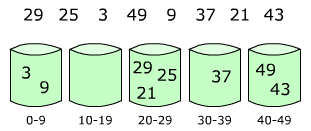SORTING
Research an application or scenario that the following sorting algorithms can be applied (include a description and an image):
known as
sinking sort, is a simple sorting algorithm that works by repeatedly stepping through the list to be sorted, comparing each pair of adjacent items and swapping them if they are in the wrong order.

Selection sort is noted for its simplicity, and also has performance advantages over more complicated algorithms in certain situations, particularly where auxiliary memory is limited.
is a simple sorting algorithm: a comparison sort in which the sorted array (or list) is built one entry at a time.

is an in-place comparison sort. It generalizes an exchanging sort, such as insertion or bubble sort, by allowing the comparison and exchange of elements that lie far apart

is a sorting algorithm that works by partitioning an array into a number of buckets. Each bucket is then sorted individually, either using a different sorting algorithm, or by recursively applying the bucket sorting algorithm.


is an
O(
n log
n) comparison-based sorting algorithm. Most implementations produce a stable sort, which means that the implementation preserves the input order of equal elements in the sorted output.

a sorting algorithm developed by Tony Hoare that, on average, makes
O(nlog n) comparisons to sort
n items.














